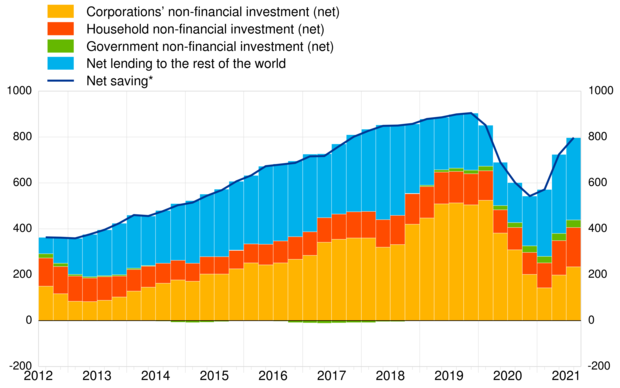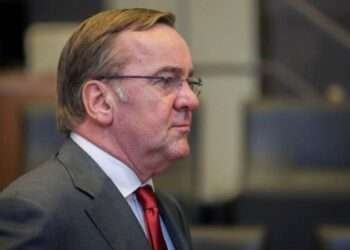Euro area net lending to the rest of the world increased to €358 billion in Q3 2021 from €345 billion in the previous quarter, according to statistical release by the European Central Bank (ECB) on Thursday, January 27, 2022.
Net lending by households however, decreased to €675 billion, accounting for 7.0% of net disposable income in Q3 2021 after a 7.7% decline in the previous quarter.
According to the ECB, Net lending of non-financial corporations (€318 billion, 3.3% of net disposable income) and financial corporations (€115 billion, 1.2% of net disposable income) were broadly stable. The overall decrease in net lending by the total private sector was lower than the decline in net borrowing by the government sector of 7.8% of net disposable income.

Euro area net saving increased to €776 billion (8.1% of euro area net disposable income) year-on-year in the third quarter of 2021, compared with €714 billion in the previous quarter. Euro area net non-financial investment grew to €440 billion (4.6% of net disposable income), owing to higher investment by non-financial corporations and households, while net investment by financial corporations and government was broadly unchanged.
Households investment
The annual growth rate of household financial investment decreased to 3.9% in the third quarter of 2021, from 4.1% in the previous quarter. This deceleration was mainly due to currency and deposits growing at a lower rate (6.1%, after 6.8%), and net sales of debt securities increasing more strongly (-11.1%, after ‑10.0%).
“Households were net buyers of listed shares. By issuing sector, they were net buyers of listed shares of non-financial corporations, insurance corporations and the rest of the world (i.e. shares issued by non-residents), while shares of MFIs were sold on a net basis. Households continued to sell debt securities (in net terms) issued by MFIs, government, other financial institutions and the rest of the world, while debt securities issued by insurance corporations were bought on a net basis”.
ECB
The household debt-to-income ratio increased to 97.0% in the third quarter of 2021 from 95.4% in the third quarter of 2020, as loans to households grew faster than disposable income. The household debt-to-GDP ratio however, decreased to 60.8% in the third quarter of 2021 from 61.1% in the third quarter of 2020.

The ECB explained that the debt-to-GDP and the debt-to-income ratios were calculated as the outstanding amount of debt in the reference quarter divided by the sum of GDP (or income) in the four quarters to the reference quarter. The ratio of non-financial transactions (e.g. savings) as a percentage of income or GDP was also calculated as the sum of the four quarters to the reference quarter for both numerator and denominator.
Non-financial corporations
In the third quarter of 2021, the annual growth rate of financing of non-financial corporations increased to 2.5% from 2.3% in the previous quarter, following an acceleration in financing by loans and trade credits.
The ECB stated that Loan financing accelerated as intercompany loans and loans from non-MFI financial corporations increased at a higher rate, and loans from the rest of the world declined at a lower rate. Loans from MFIs grew at a broadly unchanged rate, and loans from government increased at a lower rate.
Non-financial corporations’ debt-to-GDP ratio (consolidated measure) decreased to 79.8% in the third quarter of 2021 from 81.9% in the third quarter of 2020. The non-consolidated wider debt measure declined also to 143.1% from 143.7% of GDP, the ECB highlighted.
The report states that the data was drawn from a second release of quarterly euro area sector accounts from the European Central Bank (ECB) and Eurostat, the statistical office of the European Union. The release incorporates revisions and completed data for all sectors compared with the first quarterly release on ‘Euro area households and non-financial corporations’ on January 11, 2022.
The next release of the Household Sector Report containing results for the euro area and all EU countries is scheduled for February 8, 2022.
READ ALSO: Play it Safe By Holding Policy Rate At Its Current Level, IEA Urges BoG























